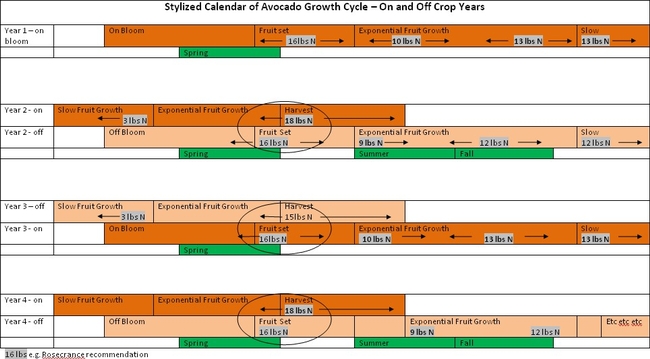- Author: Ben Faber
Plants, therefore avocados, go through different growth stages, so called phenological stages, regular periods where they grow and differentiate from seed to various vegetative stages, flowering and finally seed production. Avocado has a preset pattern of phenology that occurs depending on variety and where it is grown, driven by light, temperature, water availability and often by different stresses, such as cold, heat, and heavy or light crop load.
Differences in crop development impact the timing of cultural practices, such as fertilization, irrigation, phytophthora treatment, pollination and gibberellin sprays. For instance, nitrogen fertilization is often recommended by month of the year, rather than growth stage of the tree. Several recent efforts indicated that the timing of nitrogen fertilizer may have significant impacts on yield and that two times the fertilizer rates in April and November may result in substantial yield increase. Available information indicates the April timing might correspond to fruit set for the Irvine area compared to early bloom for Santa Barbara and San Luis. By November, Irvine's current year's crop may have been harvested three months previously. In San Luis Obispo, harvest may have just ended. So just going by date is insufficient for guiding many horticultural activities.
California's trees often have two crops maturing at the same time. It becomes especially pronounced the further north the production. The management of multiple crops on each tree becomes more important and more confusing as the length of time the fruit remains on the tree. Carrying two and even three loads of crop increases the potential for alternate bearing. Reduction in alternate bearing has been determined to be an important strategic requirement for California's growers. Understanding the impacts of cultural practices on alternate bearing is important. For example, the chart below demonstrates a stylized calendar of the avocado growth cycle for California. Rate and application timing of nitrogen as predicted by the Avocado Nitrogen Model proposed by Rosecrance et al. (2013 and Calculator) are noted for a 15,000 per acre yield outcome. The “on” year suggests nitrogen rate for the late fruit growth/harvest/summer and fall flush period is 15 lbs. This application coincides with the fruit set timing for 16 lbs of N for the “off” bloom crop during the later bloom/fruit set/spring shoot growth phase. Rates and timings to support these crops ought then be combined and represent the 2X fertilizer rate that Lovatt (2001) found to have significant effects on yields.
Taking into account the actual phenology, what is happening in your trees, then is important for assessing when to make N applications. In the winter and spring of 2023, it seems like everything was on a different cycle. Thrips delayed their appearance, flowering was erratic. Honeybees seemed to have found somewhere else to hang out, because they were not flying in the avocado trees. And then suddenly, we had some fruit set in Ventura in late June. This is a really clear example of the problem of following a cookbook to farming avocados. The point here is that just going by the calendar is not going to meet the needs of the tree. The phenological stages of the tree in your environment needs to be taken into consideration.
Notes:
Lovatt, C.J. 2001 Properly Timed Soilapplied Nitrogen Fertilizer Increases Yield and Fruit Size of ‘Hass' Avocado. J. Amer. Soc. Hort. Sci. 126(5): 555?559.
Rosecrance, R., Lovatt, C.J., 2013. Management tools for fertilization of the 'Hass' avocado. FREP final report.
Calculator: https://rrosecrance.yourweb.csuchico.edu/Model/AvoModel/Avo2NKModel.html




